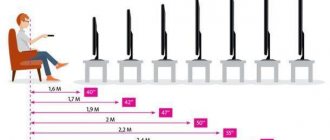The TV diagonal is the distance between two opposite corners of the display.
The size of the picture and the ease of viewing it depend on the diagonal. The larger the diagonal, the more comfortable it is to watch TV. But it should be borne in mind that large screens are not suitable for solving household tasks: for games, watching movies, photos, for the Internet. How to choose the TV diagonal. In terms of screen size, TVs with diagonals of 33-42 inches (approximately 80-120 cm) are now leading. Diagonal sizes smaller than 32 inches are rare, but such models still exist. As a rule, these are compact TVs. To connect a computer or laptop to them you will need a special device - a TV tuner.
The need to calculate the diagonal of the foundation
If the diagonal is calculated incorrectly, all further construction will diverge from the plan.
The project involves selecting structural elements exactly to size so that there are no distortions during construction. The length of the beam or floor slab is taken with the required depth of support, which is taken according to the structural calculation. When marking the foundation, extreme precision is needed, because... deviation in size will lead to divergence of vertical structures.
Horizontal elements may not fit into the design position or fall out of the installation space, so recalculation of the length, as well as other indicators, will be required.
Correct marking of the base leads to pleasant bonuses when constructing a building:
- ease of construction of walls and use of prefabricated elements;
- compliance with the cost and material savings envisaged by the project;
- construction of the facility without deviations from the project.
Before measuring the diagonal of the foundation, you need to level the construction site so that it is convenient to mark lines on the ground. Almost always, building structures and materials from insulating mats to boards and wall panels have right angles, so the foundation is also marked taking into account these requirements.
If the diagonals of the rectangle are equal, the surveyor has completed an ideal marking. If the diagonals are not equal, the design is not a rectangle. But an isosceles trapezoid also produces diagonals of the same length, so check the sides of the angle according to the principle of the golden ratio using a long cord and a tape measure.
Difficulties with incorrect markings
Violation of the geometry of the foundation reduces the strength of the walls.
Incorrect transfer of dimensions to the terrain and neglect to compare diagonals will lead to the appearance of a rhombus or trapezoid on the surface of the earth. When constructing the foundation itself, this may not become noticeable, but the first laying of slabs above the basement will reveal inconsistencies and lead to wasted time for recalculating prefabricated elements or reworking the foundation.
If the slab is supported less than the required depth, after receiving loads from equipment or people, it may break off the supporting part of the wall and fall. Such a nuisance will affect horizontal floor elements on all floors of a high-rise building and will be repeated right up to the roof.
It is difficult to install a roof if the dimensions between the beams do not match, the trusses have to be installed larger, and in other places the dimensions must be reduced. The labor intensity of the work increases, because the performer acts in an unusual role for him as a designer and designer.
The installation of the roof covering will become more complicated, because... sheets of corrugated board or slate are produced with right angles. Prefabricated corner drainage elements are also designed to be installed at 90°, the gutter will move away from the edge of the roof, and water will fall on the vertical fences, causing the walls to become damp.
Difficulties will arise with subsequent work, so you need to check the diagonal of the foundation and compare the results. Similarly, measurements are taken after installing the formwork to confirm the correctness of the calculations.
Correct calculation of the diagonal of the foundation
After studying the base plan, you need to start marking one of the sides. This can be a side part, front or rear, in this case this is not an important condition, because Only the directional orientation is taken into account.
The length of the foundation wall is not taken into account; you can take 1.0 meter more from the location of the upcoming corners. At these points the stakes are driven in and the twine is pulled. A margin of length is given so that when digging a trench the peg will not be pulled out, and it remains to indicate the direction of the side.
The pegs are replaced with a board 1–2 meters long with stakes nailed to the end. The cord attached to them can be quickly moved from side to side if necessary. Such a work device is called a cast-off; it allows you to outline an area with an accuracy of a few millimeters.
Operating procedure:
- After stretching the twine, find a reference point along the length and determine the angle of the foundation; attach a clothespin to the twine at this point or drive a stake into the ground, so 2 angles appear.
- Do the same with the perpendicular side and determine the direction.
- Before calculating the diagonal of a right triangle, lay 3 and 4 equal parts on the sides and mark them on twine (for example, 3 and 4 meters).
- The dependence of the distance between the marked points is such that the hypotenuse must be equal to five parts (5 meters) and not differ even by a centimeter, otherwise a bevel will occur.
It is difficult to immediately obtain the correct markup result. A distance of less than five parts will mean an acute angle, and more will mean a value exceeding 90°.
Convert inches to centimeters
It's no secret that the above parameter is in inches. Many users may have a question: why not indicate the screen diagonal in centimeters. Firstly, you should know that the inch is a non-metric system, but in the Russian Federation they use the metric one.
In modern Russia, this unit is practically not used in everyday life, with the exception of certain industrial sectors, for example, the production and sale of televisions. The measurement in inches is due to the fact that the first TVs appeared in the USA, where the non-metric system is used.
Many people may also be interested in why they don’t use the length and width of the screen instead of the diagonal. The fact is that modern TV manufacturers produce only with a standard length-to-width ratio (4:3, you can also find 16:9).
Reference! Because of this, only one value is sufficient - the screen diagonal.
In general, if we take it from history, an inch is equal to the distance of the far phalanx of a person’s thumb. If we convert to a system more familiar to Russia, then 1 inch = 2.54 centimeters or 25 millimeters. Accordingly, to calculate in centimeters, you need to multiply the number of inches by 2.54.
Necessary tools for work
Tools for marking the foundation
When digging trenches with an excavator, remove the cords that are stretched with distance from the corners, and the places of the sides are marked on the ground by sprinkling with a contrasting substance, for example, light sand or chalk. The cast-off elements are painted with bright paint so that the excavator operator can see them and not run over the markings. After digging a trench, the cords are pulled over the old place and the location of the holes or pits is checked.
The foundation diagonal is calculated using tools and devices:
- stakes made of wood or smooth reinforcement, without curvature;
- even pieces of metal profile or dry slats 2 - 2.5 meters long for horizontal transfer of points;
- nylon cord or strong twine;
- nails, screws or self-tapping screws;
- square, tape measure, hammer, scissors;
- plumb line, water or laser level.
Surveyors use a theodolite to mark out angles and give elevation marks. Private owners do not have such a tool; working with it requires skill. You can correctly measure the diagonal of a house using simple devices.
Laser pointers and a building level are attached to the square - such a device will show high accuracy when marking. Large protractors and squares are sold; it is better to take ones that make it easier to transfer the plan lines to the terrain. The initial marking is very important to begin construction, so it is advisable to calculate the diagonal several times to be sure of the correct work.
Aligning the size of a rectangle
In a rectangle, all angles must be equal to 90°, otherwise the result will be an unequal figure with distorted walls. The outline of the foundation has an outer and an inner side, so the requirement for rectangularity applies to both contours. It is easiest to adjust the value for a simple rectangular house that has four walls.
Sometimes the foundations have a complex structure in plan, for example, additional monolithic strips are made for an extension or veranda, and the fireplace room is considered as an external room. In this case, the marking is complicated by the fact that the area of the house will be made up of separate rectangles, which are marked separately.
After planning, each figure is checked for compliance with other parts and right angles are also established between the component elements. The original side is tied to some base on the ground that looks straight. This could be a fence, tram tracks or the curb of an asphalt road. An equal distance is set off from this line to indicate the first side of the desired foundation plan.
After the final marking, you need to correctly calculate the diagonal and compare the distance between the first-third and second-fourth vertices of the rectangle on the ground. The distances should be perfectly equal. The length of the opposite sides is also checked, which should also be equal.
general information
In problems in geometry and physics, you have to find some parameters of a rectangle: angles, sides, perimeter, area and diagonals. All these quantities are interconnected by certain relationships. Everyone should be able to calculate them, since this is necessary not only for solving mathematical problems, but also in life. For example, when laying expanded clay tiles on the floor.
Using the property of diagonals, you can determine the method of its laying. In addition, in physics, sometimes you need to calculate the cross-sectional area, but the required formula is unknown. When planning the purchase of building materials, you need to calculate their quantity by calculating the area or perimeter of the room.
However, formulas for making calculations are not enough, since you need to identify a geometric figure. For each of them, different ratios apply. If the definition is incorrect, the calculations will turn out to be unreliable, and this has a negative impact not only on exams or tests, but also in the financial sphere.
Finding the third and fourth angles
When calculating, the Pythagorean theorem is used.
The correspondence of the parts in a triangle along which a right angle is marked on the site can be checked using the Pythagorean theorem. It is expressed by the formula a² + b² = c²: the square of the hypotenuse is equal to the sum of the squares of the legs.
To calculate the length of the connecting hypotenuse, you need to calculate the square of one distance on the cord with the square of the other side of the angle and add the resulting values. The square root of the result should be calculated to obtain the length of the hypotenuse. This way you can align the diagonal of the rectangle to get a perfect right angle.
The third and fourth corners are found in a similar way using the starting vertex and the existing side. After setting the last angle, the opposite diagonals and sides in the figure are checked for comparison. A cord is used that does not stretch in length so as not to distort the measurements.
The ancient way to measure the diagonal of a house involves using a string with 13 knots tied on it at absolutely equal distances from each other. There were 3 distances between nodes on one side of the rectangle, with the fourth coinciding with the vertex of the corner. After the top, 4 such segments were measured. The hypotenuse accounted for the remaining 5 spaces, and the first knot when tensioned had to coincide with the 13th tied element.
Answers from experts
Aina:
Problem one: L = 100 cmb = 100 cmWhat is d equal to?
solution:
(L*L)+(b*b)=d*d
(100*100)+(100*100)=d*d (d squared)10000+10000=d*d20000=d*dd=141.42 - square root of d
Problem two: L = 100 cmb = 120 cmWhat is d equal to?
solution:
(L*L)+(b*b)=d*d
(100*100)+(120*120)=d*d10000+14400=d*d24400=d*dd=156.2 - square root of d
Wild strawberry:
Measure with a ruler.
User deleted:
Listen Brahman.. have you ever heard about the Pythagorean theorem? If not, then what kind of master are you?
I'm just like this:
according to the Pythagorean theorem
width squared plus length squared. then extract the root
MUSAFAR:
square root of the sum of the width squared and the length squared
Prokhor:
The square of the hypotenuse is equal to the sum of the squares of the legs.
Firdaus Shaikhutdinova:
by Pythgore's theorem. The dioganal is equal to the square root of the sum of the squares of the width and length.
agentessa007:
Divide the rectangle by a diagonal and count as triangles. 2 sides are known - find the third.
quick angry:
This is great)) ) For the first time I see a person who didn’t go to the fourth grade and didn’t even watch the mess about “Pythagorean Pants”))))
Natalia Efimtseva:
You can add the width squared to the length squared and you get your diagonal squared))))) But it’s easier to actually measure with a ruler)))
AlexYR:
According to the Pythagorean theorem!
Sergey Technic:
a=lengthb=width=diagonal
Marina Vasilievna:
Do the rectangle and the table have anything to do with each other?
Daria Lyutova:
Width squared plus length squared equals diagonal squared. Take the square root and get the length of the diagonal.
volflot:
If sides are a and b, then: sqr(a^2+b^2)
Maria:
Express the square root of the sum of the squares of two adjacent sides of the rectangle
Victor Shchukin:
Call her into your office and tell her that she is fired and let her go to the accounting department to get the payment. If you mean purely arithmetic, then it’s difficult to help. I should have gone to school in the fifth grade...
Alexey Tolstov:
A rectangle with a diagonal consists of 2 triangles, respectively, according to the Pythagorean theorem, the hypotenuse is equal to the root of the sum of the squares of the long and short sides of the rectangle Г=root(a2+b2)
Oleg Lisovsky:
I support Daria)) the sum of the squares of two legs is equal to the square of the hypotenuse (diagonal)
Makarova Irina:
nnnnnnnnnnnda, how seriously everyone answers the question... Even a poor student knows the Pythagorean Theorem!!!
3:
damn, why didn’t you go to school?
Alex II Cat:
“Even a poor student knows the Pythagorean Theorem” - well, yes, of course. Anyone can and will answer you about Pythagorean pants, but as I’ve learned from my own experience, not every C grade student can apply it)))
Ilya Zaitsev:
Aren't you ashamed to ask such questions?
User deleted:
Well, you guys really need to extract the root from the result a^+b^











